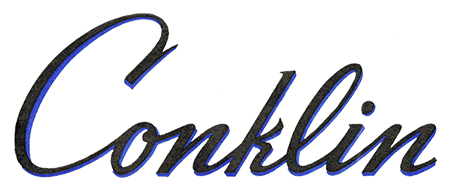Conklin Glider 1944-1946
by Jim Mamoulides, May 25, 2002, updated November 24, 2023
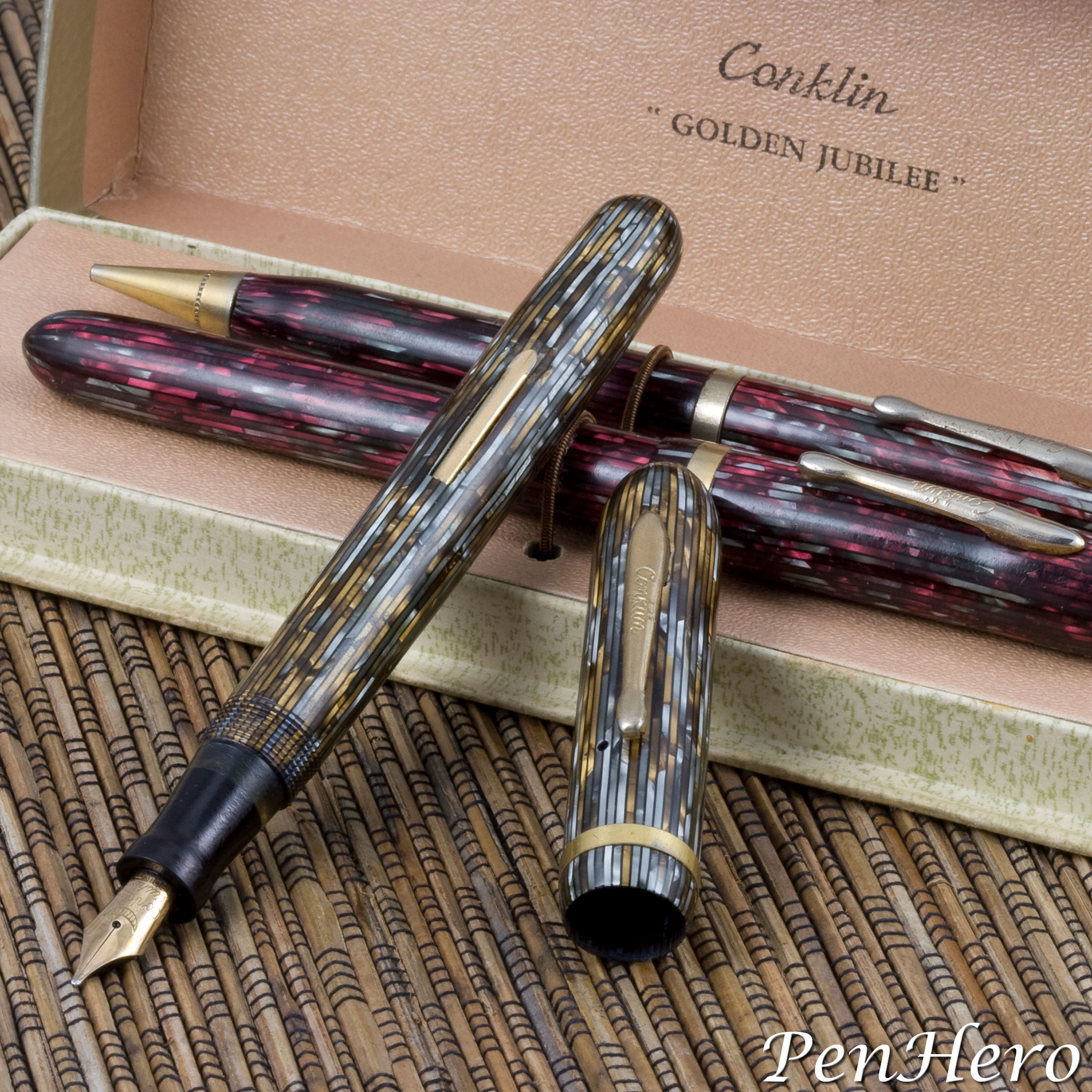 Conklin Glider standard size brown (front) and slender burgundy set in box
Conklin Glider standard size brown (front) and slender burgundy set in box
The Last Quality Conklin
The Conklin Glider was the last quality pen made by the venerable company and describing it as a quality pen is something of a stretch. Roy Conklin and the pen company that bore his name are probably most strongly associated with the first successful self-filling pen, the Conklin Crescent Filler. Conklin was established in 1898 by Roy Conklin and C. B. Gundy as the Self-Filling Fountain Pen Company in Toledo, Ohio and in 1901 the name was changed to the Conklin Pen Manufacturing Company, the same year Roy Conklin’s Crescent Filler patent was awarded. Conklin Crescent Filler pens sold well, propelling the company into the majors of pen manufacturing.
Gliders were cheaply made compared to the earlier Conklin Toledo and pre-Glider Chicago pens, with lightly gold plated trim that wore off easily, cap bands that easily worked loose and poor fit and finish. The two best things about the pens were the 14 karat gold Cushon Point nibs and the interesting striped celluloid, described in Conklin advertisements as having "dichro-plastic striped inlay patterns.”
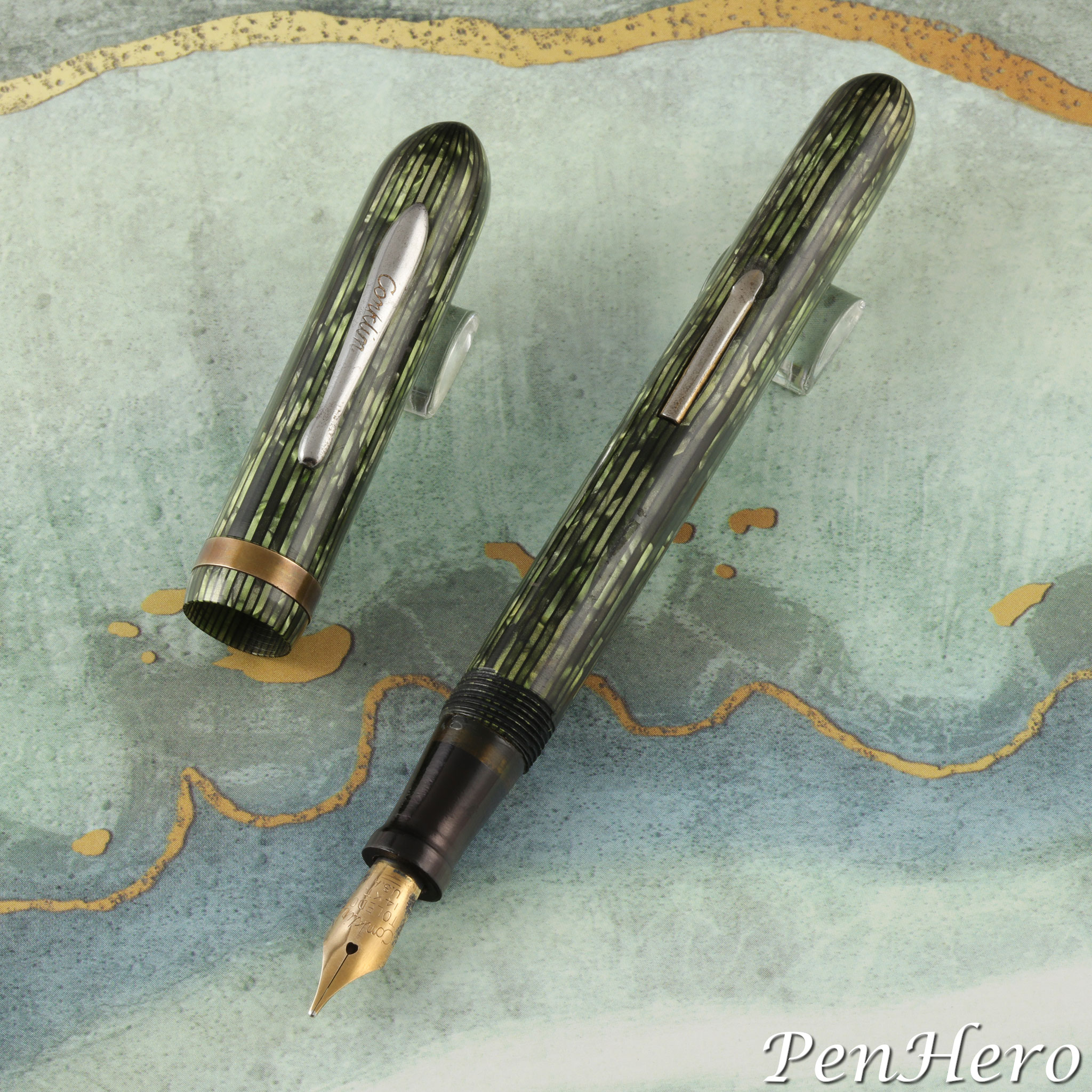 Conklin Glider slender green
Conklin Glider slender green
Glider Advertising Campaigns
The earliest advertisement for the Glider appears in the Philadelphia Inquirer on July 16, 1944 and also kicks off an advertising campaign that could be called “Names That Endure.” Each month featured a famous person or place. The campaign changed monthly and the list below shows who or what was the topic. Of note is Mark Twain, who was also featured in early Conklin advertisements. There is a gap from February through July, 1945, where I could find no campaign ads. I could not find any information as to why.
July 1944: Abraham Lincoln August 1944: Mt Rushmore September 1944: Ben Franklin October 1944: Mark Twain November 1944: Will Rogers December 1944: Charles Dickens (this is a full page ad) January 1945: Thomas Edison August 1945: Louis Pasteur
Conklin then launched a new campaign, “It’s so easy to write with a Conklin,” with the earliest ad I found appearing in the September 29, 1945 Saturday Evening Post. The campaign ran through January 1946, with the latest advertisement appearing in the January 26, 1946 Collier's Weekly. The January 19, 1946 Saturday Evening Post has the only full color ad for the Glider that I've found. After that big full color splash and the Collier's ad, there are no more corporate ads for the Glider. I also couldn’t find a single ad that offers Conklin Gliders by name even from dealers after 1946. There are dealer discount ads in 1947 showing Conklin pens that once sold for $2.75, which was the Glider's price point, now selling for $1.00, indicating that Gliders were by then on closeout.
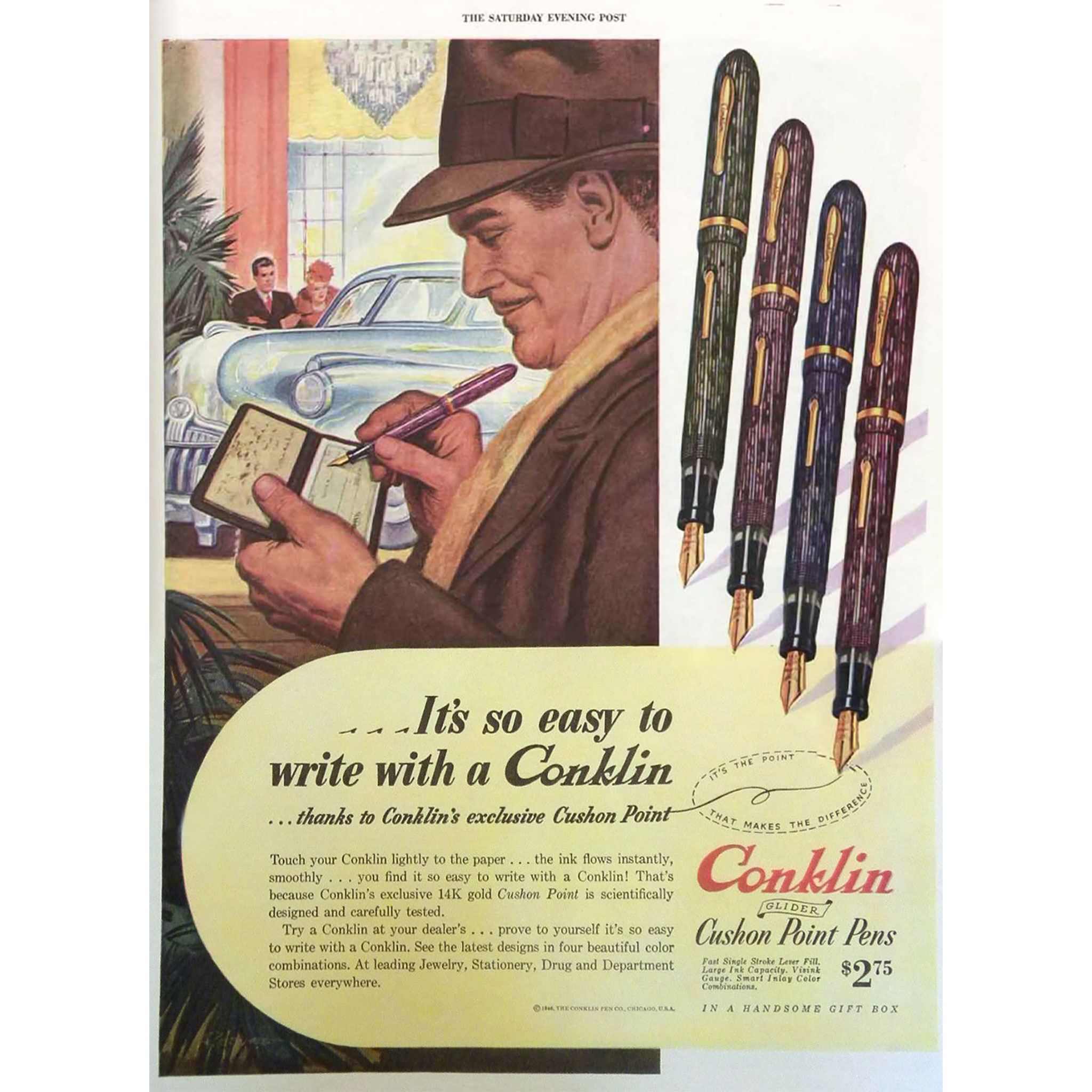 Advertisement, Saturday Evening Post, January 19, 1946
Advertisement, Saturday Evening Post, January 19, 1946
Were they made after 1946? The complete absence of Gliders appearing even in dealer ads after 1946 would suggest, "No." Then I found and photographed a burgundy slender Glider pen and pencil set for this article that was packed in a "Conklin Golden Jubilee" presentation box. That would date the box to 1948, given the company's establishment in 1898. Conklin had a history of running regular mass closeouts after 1937, so my thinking is this is more about clearing out old stock than promoting a production pen. Could it be that they were still being made, but Conklin could not afford any advertising at that point or offer dealer advertising co-marketing credits? The fundamental problem is a lack of mention of Gliders by name at all. It appears more likely to me that Gliders were dumped as closeouts from 1947 forward until they were all gone.
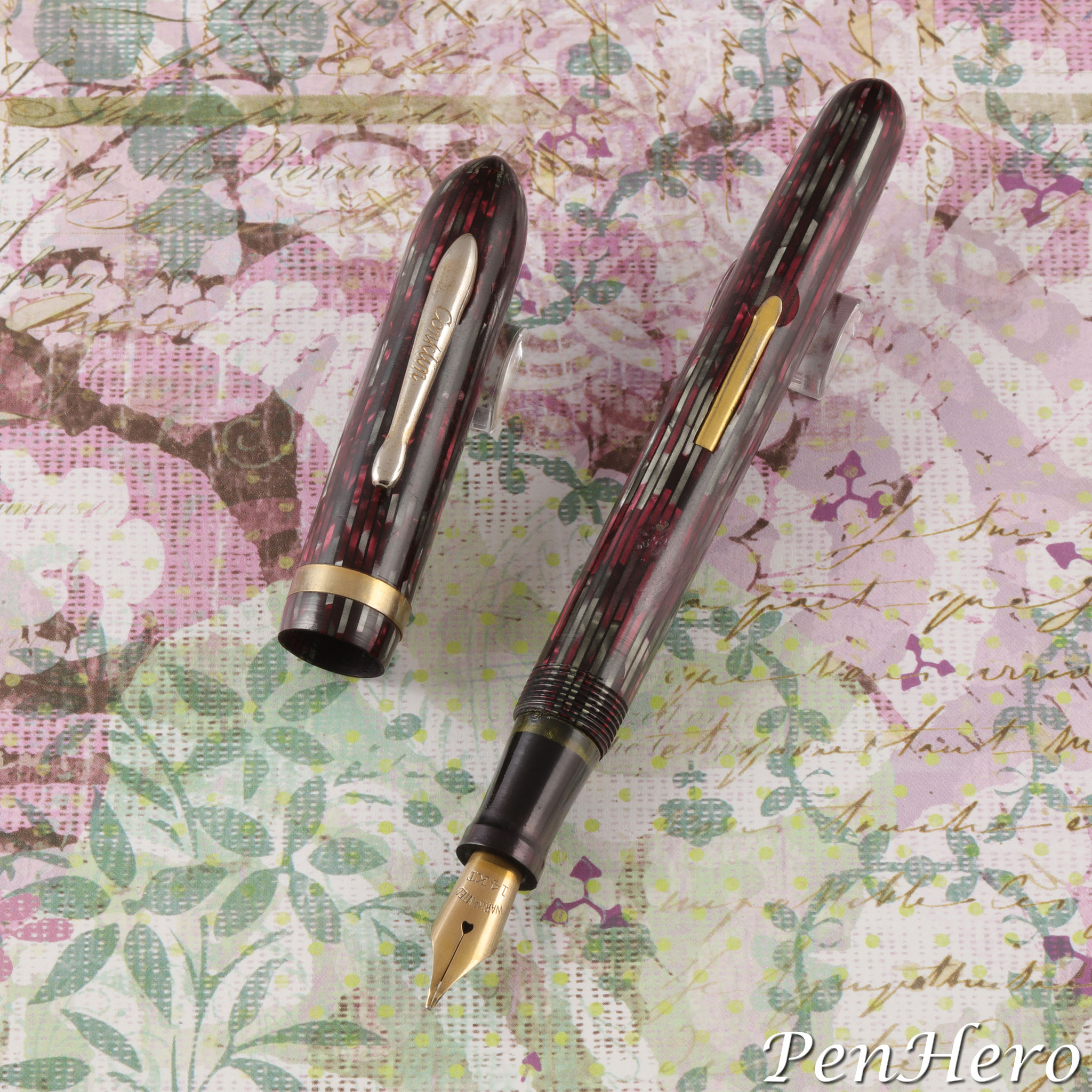 Conklin Glider slender burgundy
Conklin Glider slender burgundy
Gliders were offered in four striped colors: green, blue, brown and burgundy. The colors can be seen in the full page ad in the January 19, 1946 Saturday Evening Post. The Glider fountain pen sold for $2.75 and a pen and pencil set was $3.95. What about other colors? Most pen companies also offered solid black alongside their colorful pens. Black is not mentioned in any advertisements I’ve been able to review. The earliest ad says, “Available in many smart color combinations.” Does that mean more than the four advertised striped colors? I can’t say for certain, but there are Glider-like pens in celluloids other than the striped pens shown in this article. I’ve also never seen a pen that is clearly a black Glider. Since I don't have any Conklin price lists from 1944-1946 I'm not going to rule out other colors, but the four striped ones are the only ones ever mentioned in advertisements.
The other puzzler is how many Glider types were made? Advertisements for the Glider describe only one model, which I'll call the standard size, but if you see enough striped Gliders it will become quickly clear that there are three sizes, a slender size, a standard size, that is probably what’s shown in ads, and an oversize, wider profile pen with a wide cap band. I do think these are all Gliders as they are the same pen, in the same striped celluloid, in three different sizes. There are also two pencil sizes that I am aware of, one about the same length as the standard and slender pen and a shorter one. Interestingly, the slender burgundy pen was in the box with the longer pencil. The pencils differ not only in length, but in how they are made, as can be seen in the photo below.
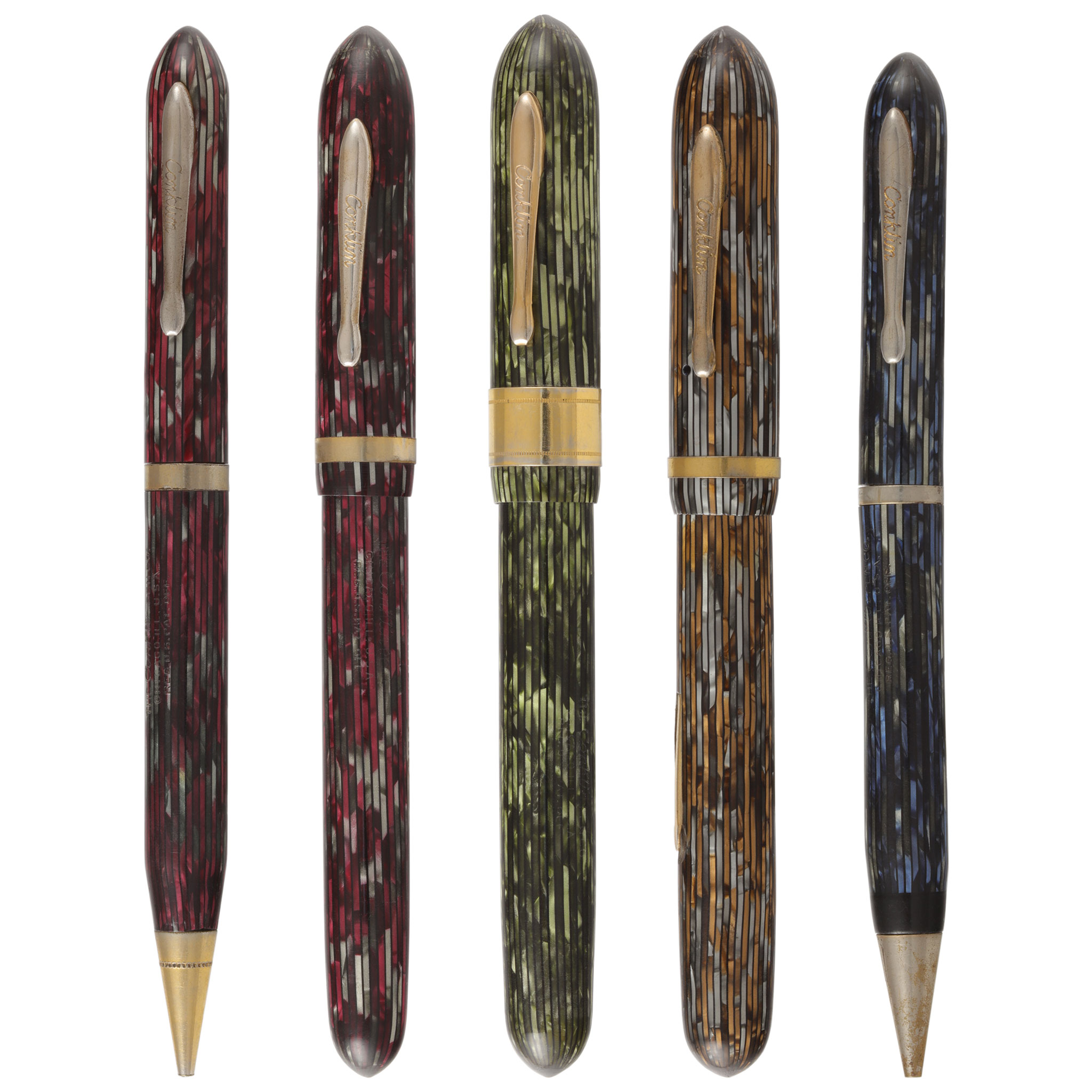 Conklin Glider pen and pencil sizes
Conklin Glider pen and pencil sizes
There are three known pen and two known pencil sizes (left to right above):
Twist action pencil in burgundy, longer size, about 5 inches long Slender fountain pen in burgundy, about 5 inches long capped Oversize fountain pen in green, about 5 1/16 inches long capped Standard size fountain pen in brown, about 5 inches long capped Twist action pencil in blue, shorter size, about 4 7/8 inches long
Was the Glider introduced in 1943? There is a July 25, 1943 advertisement in the Evansville Courier showing a Conklin pen and pencil set with the Glider shape, though the image is a fuzzy newspaper image, the pen model is unnamed, and it's priced $5.00 to $8.50 for the set. Pens nearly identical to the striped Glider but made of other celluloids do exist. Perhaps this ad is for one of those, or this was a Glider market test. I just don’t know. Hard to make a case from only one ad with a poor image and with no pen name given.
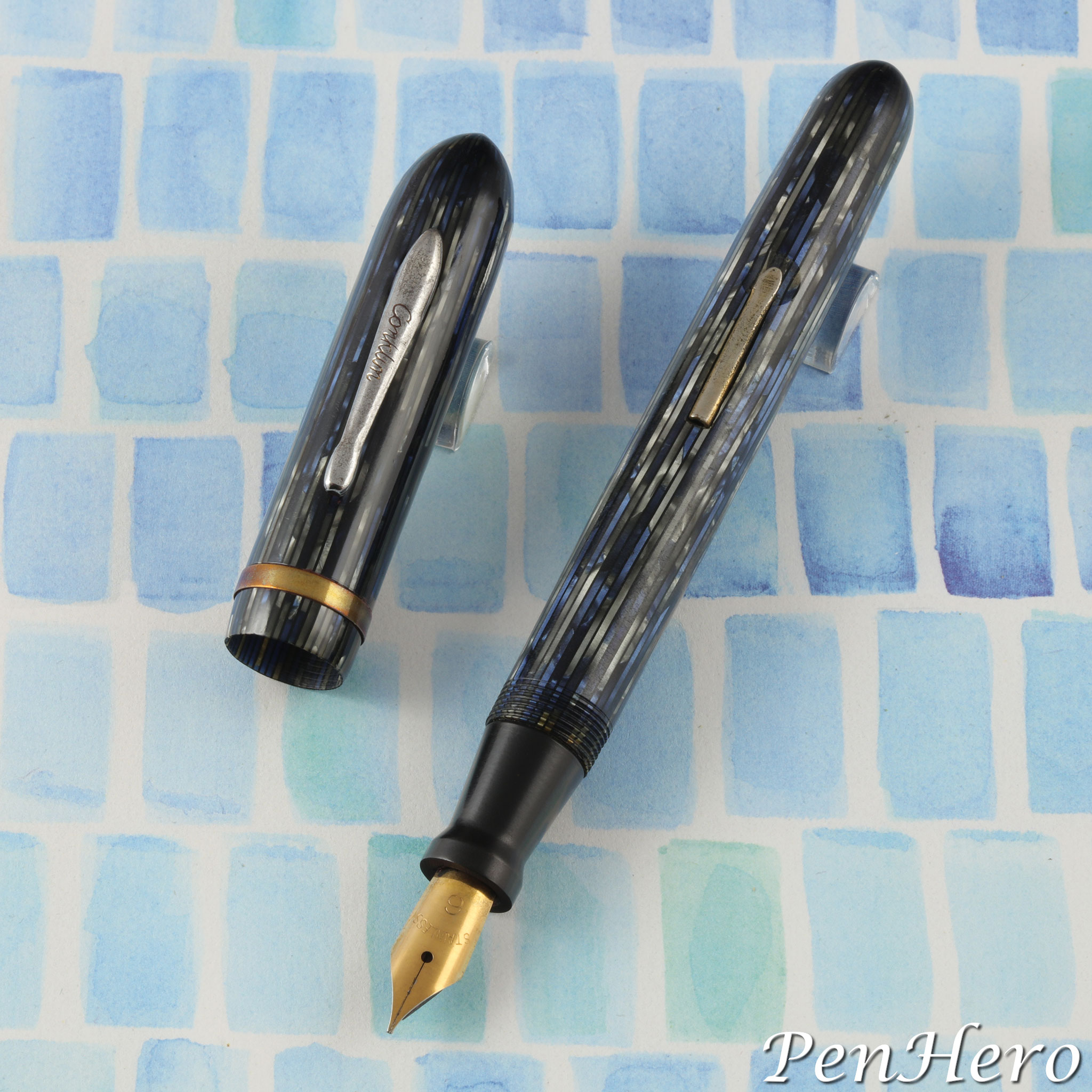 Conklin Glider standard size blue
Conklin Glider standard size blue
The Glider was the last decent pen Conklin made and it certainly is not up to the standard of previous models. Conklin introduced an even cheaper line of twist fillers and lever fillers in the late 1940s showing the company's decline into cheap pens. The company shuttered by the mid 1950s.
Identification Guide and Features: Standard Size
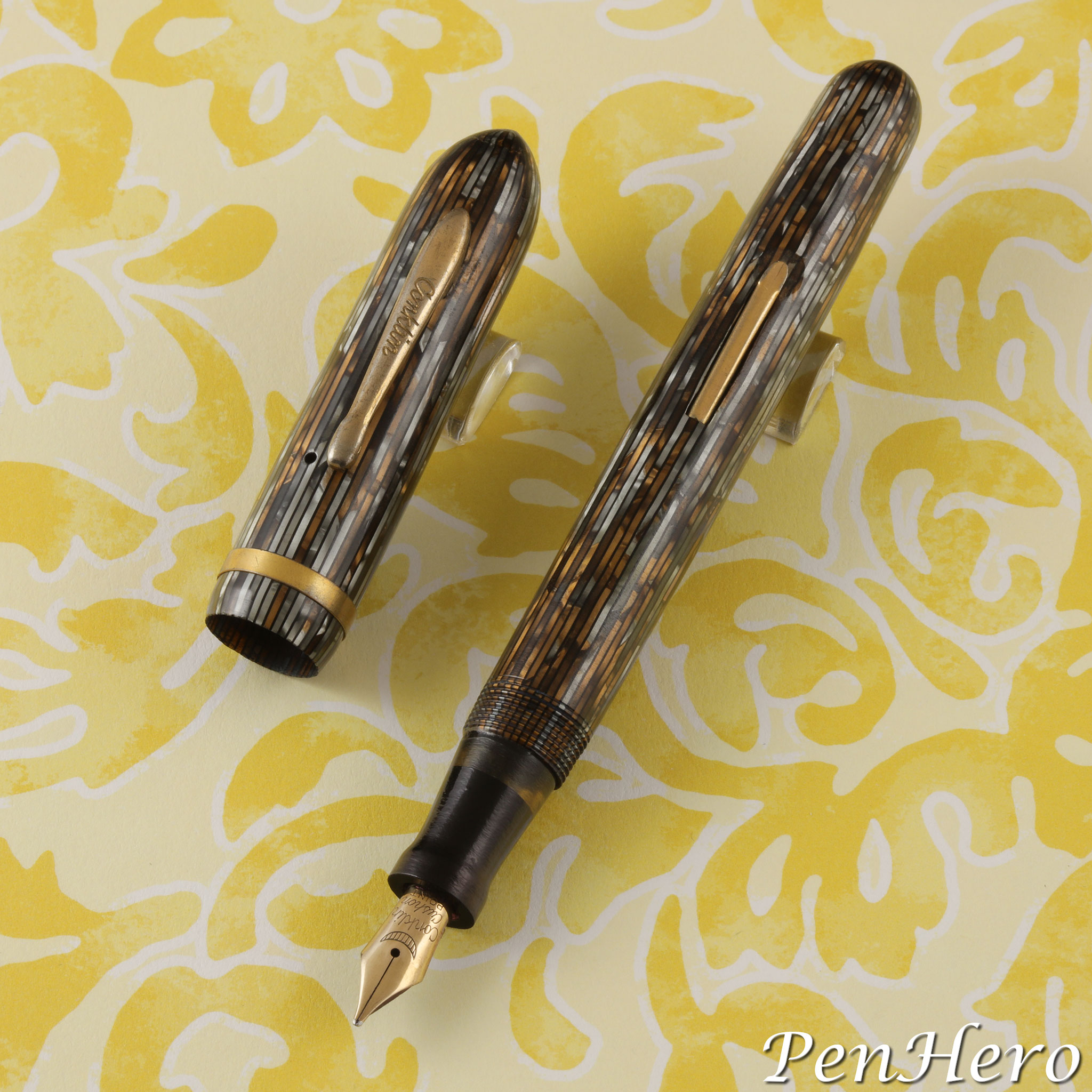 Conklin Glider standard size brown
Conklin Glider standard size brown
The Glider has some resemblance to earlier streamlined Conklins. The cap top tapers to a noticeable point, rather than the more rounded ends on the streamlined Endura Symetrik and Nozac pens. Conklin called the striped celluloid “dichro-plastic.” Most pen companies made pens in colors and black, but I’ve never seen any reference to an all black Glider in any advertisement and have never seen one in person. Maybe they made them, but I’m not convinced. The Glider has an ink-view "Visink-Gauge" section, which is actually transparent with the inner wall painted black, leaving the base 1/4 inch open to view the ink level. Gliders were originally fitted with very good quality 14 karat gold "Cushon Point" nibs, probably the only really first rate feature of the pen. "Cushon Point" is the Conklin trade name for these nibs, as common use words such as "cushion" are very difficult to trademark. The quality of the nib is the likely reason for the name Glider. Cushon Point branded nibs can be found on later Toledo made Conklin Nozacs. The Conklin Crescent logo is also stamped on the nib. The clip is a fixed type rather than the patented spring loaded type on earlier Conklin pens. The barrel imprint reads "THE Conklin PEN CO. over CHICAGO ILL. U.S.A. over REG.US.PAT.OFF".
- Striped celluloid cap and barrel in green, blue, burgundy and brown
- Gold plated clip stamped Conklin
- Gold plated 1/16 inch wide plain cap band
- Threaded cap
- 14 karat gold nib, stamped Conklin over Cushon over POINT over 14 KT over U.S.A.
- Nib grades unknown, fine and medium observed
- Ink view section
- Lever filler
- About 5 inches long capped
- Advertised price for the pen was $2.75 and a set with a matching twist action pencil was $3.95
Identification Guide and Features: Slender Size
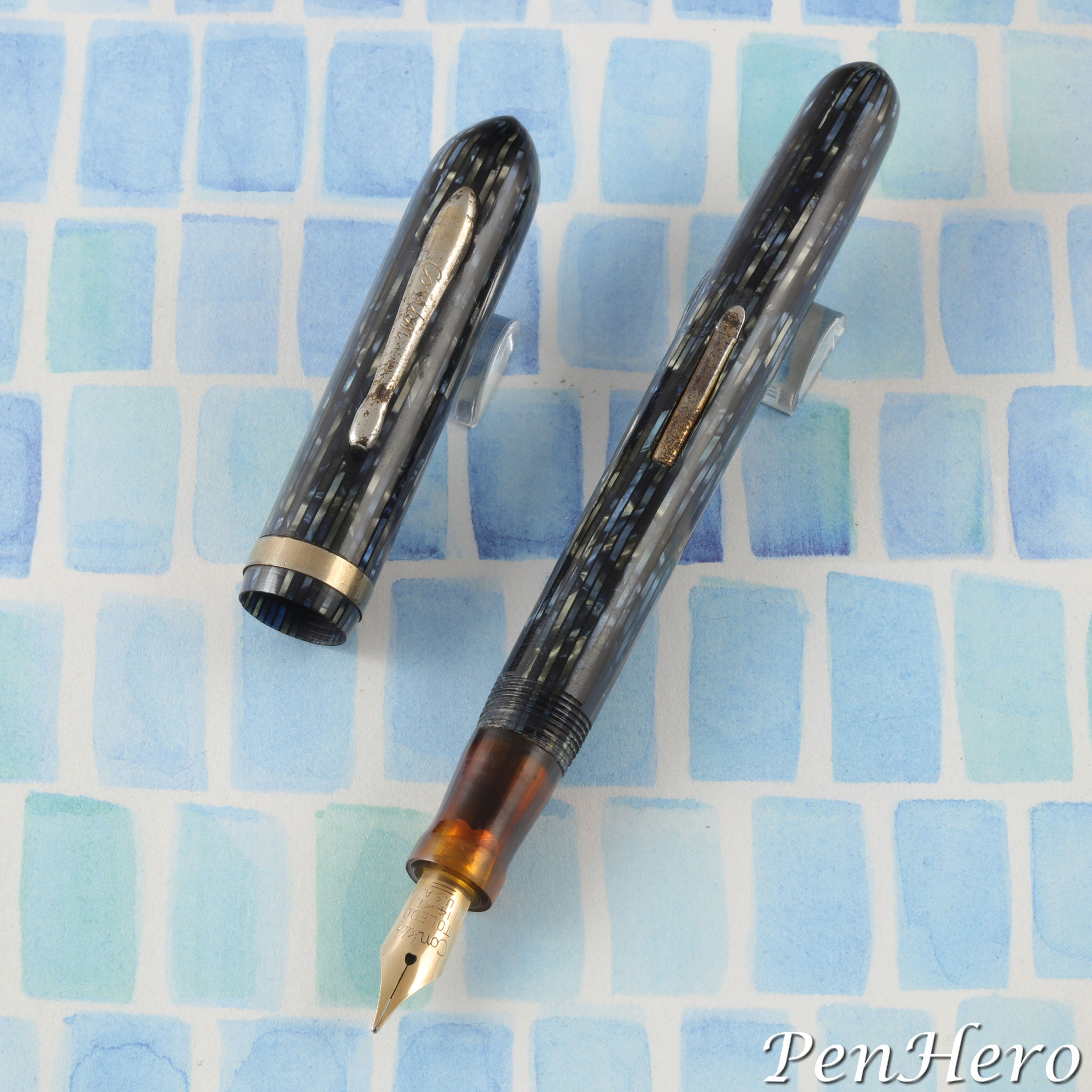 Conklin Glider slender blue
Conklin Glider slender blue
The slender Glider differs from the standard size primarily from its smaller diameter. Visually the pens are identical.
- Striped celluloid cap and barrel in green, blue, burgundy and brown
- Gold plated clip stamped Conklin
- Gold plated 1/16 inch wide plain cap band
- Threaded cap
- 14 karat gold nib, stamped Conklin over Cushon over POINT over 14 KT over U.S.A.
- Nib grades unknown, fine and medium observed
- Ink view section
- Lever filler
- About 5 inches long capped
- Price for the pen alone and set with a matching twist action pencil is unknown
Identification Guide and Features: Oversize
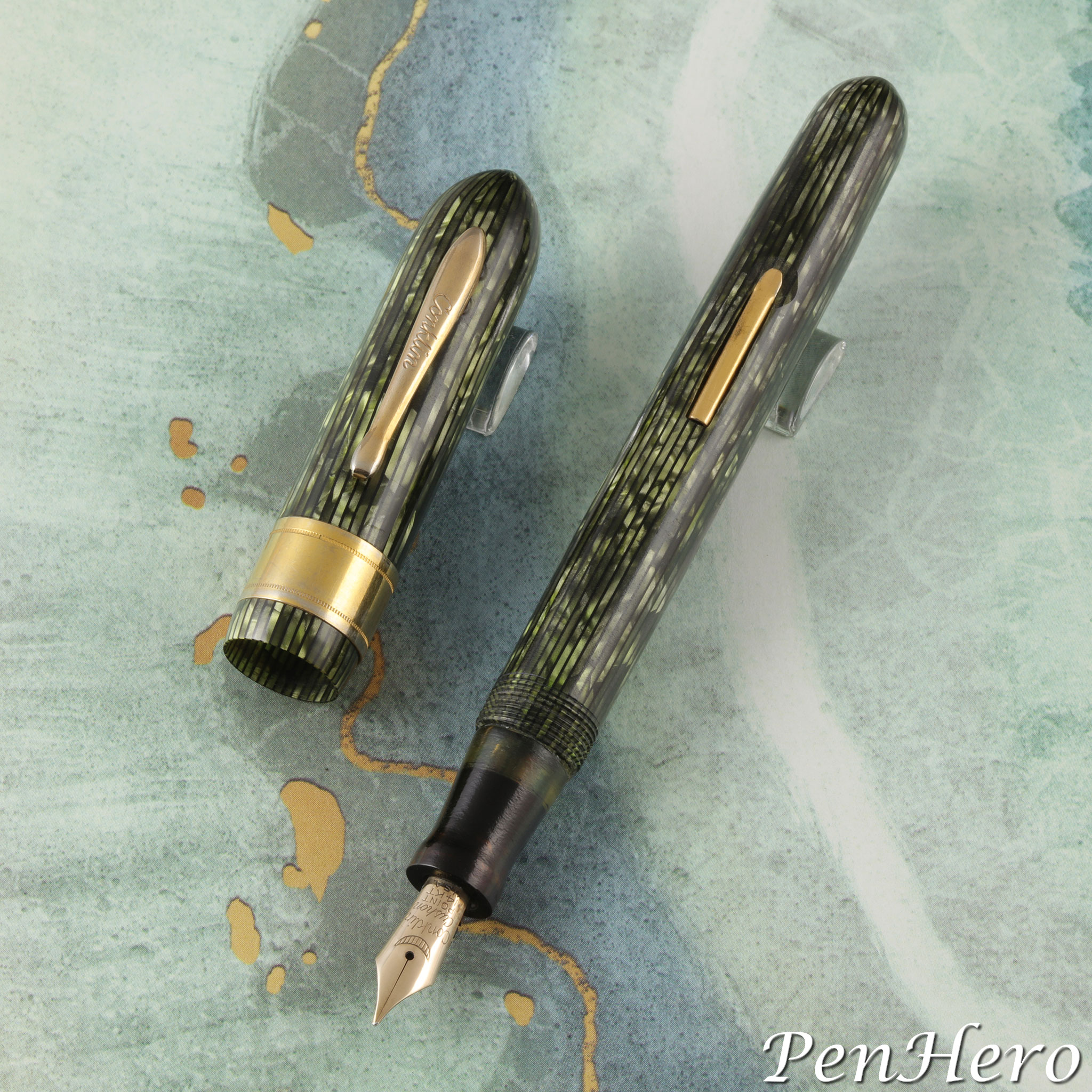 Conklin Glider oversize green
Conklin Glider oversize green
The oversize Glider is easy to distinguish from the standard size both with its much wider cap band and its noticeably larger diameter.
- Striped celluloid cap and barrel in green, blue, burgundy and brown
- Gold plated clip stamped Conklin
- Gold plated 3/8 inch wide plain cap band
- Threaded cap
- 14 karat gold nib, stamped Conklin over Cushon over POINT over 14 KT over U.S.A.
- Nib grades unknown, fine and medium observed
- Ink view section
- Lever filler
- About 5 1/16 inches long capped
- Price for the pen alone and set with a matching twist action pencil is unknown
Performance
The blue striped oversize Glider shown in this article suffers from all of the typical quality problems one would expect to find including significant wear on the lightly gold plated parts, a loose cap band, ripples in the celluloid and striations that aren't straight lines. It’s 5 1/8 inches long capped and 6 1/4 inches posted.
After some repair work, including a new ink sac and polishing, the celluloid is actually quite attractive. Many earlier Conklin celluloids are notable for having exciting patterns, and this striped celluloid is nice in its own right. There is a good bit of depth in bright light and as the pen is turned in the hand. The cap and barrel are made of a tube that begins as flat celluloid sheets and the seam can be easily seen on many pens. It’s unfortunate that the cap and barrel aren’t made to the same high standard as earlier Conklins to show off this material.
Better gold plating would make the pen more appealing, but it still is a mid 1930s design competing with newer designs from Parker, Sheaffer, and Eversharp. The pen had to look dated to potential buyers. On many examples the lost plating reveals a silver base metal. Silver was used instead of brass during World War II due to wartime restrictions on brass. The clip is a crimp on type and has almost no give, so this pen needs to go in a thin shirt pocket. It will ride high, making it not qualified for military sale, probably a bad thing for Conklin since the military bought lots of pens and pencils. Unfortunately many clips will be found sprung. The cap screws on securely.
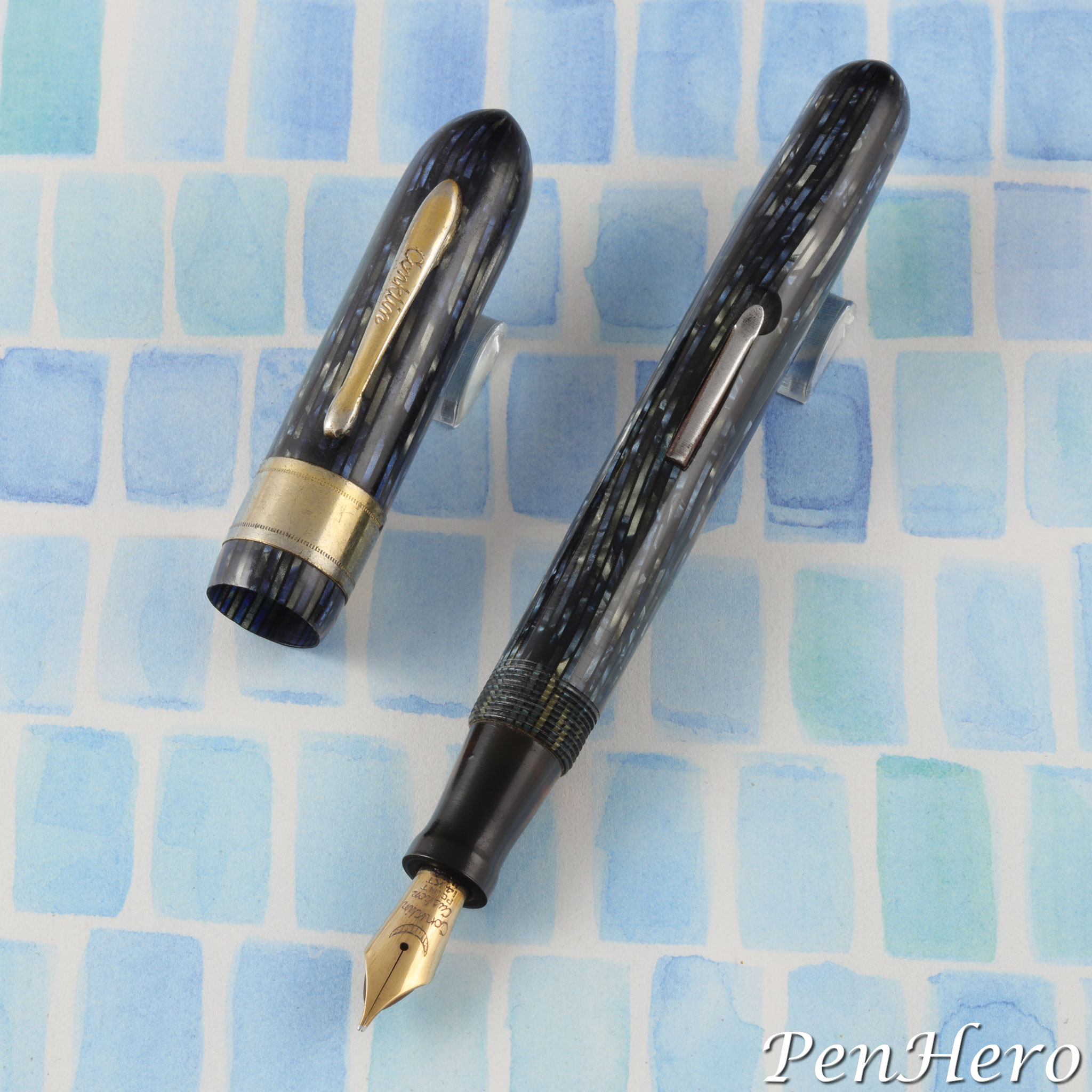 Conklin Glider oversize blue
Conklin Glider oversize blue
The Chicago firm omitted a very nice feature Conklin devised for its earlier lever filler pens, where two "feet" protrude from the end of the lever to hold it tight to the body of the pen when not being used. The lever on the Glider is therefore very ordinary, but a quick pull fills the pen well and the pen holds a lot of ink. The ink-view section is a nice touch.
The Cushon Point nib is the best feature of the pen by far and it writes a very smooth, very wet bold line and has a nice bit of flex. This is a very nice writer, something the quality of the rest of the pen can’t match.
Gliders used to be relegated to the cheapie tables at pen shows and the bargain price region of on-line auctions. With more awarness about the Cushon Point nibs on these pens, Glider prices have risen. Some collectors seek Gliders specifically to get the gold Cushon Point nib as a replacement for older Conklins. Without the Cushon Point nib, this is a very ordinary lower tier pen. They are not as well made as earlier Conklins, which shows when you hold one. Cap bands will often be loose, almost all of them will show plating loss, and considering their value, unless you are a very focused Conklin collector, investing in a high level of restoration will cost more than its worth.
There is some debate as to the collectability of Gliders, which are definitely lower grade pens than earlier, Toledo or even Chicago made pens. I would place them below all of the "first line" makers of the 1940s, such as Parker, Sheaffer and Eversharp. The nib is probably the pen's saving grace, being well made and worthy of a better pen.
Gliders are interesting to me because they are the last nice pen Conklin made with the added surprise of three sizes. Although there are no references showing anything other than the four striped color pens, it’s possible that the few known other types of Conklin pens that look like Gliders but using other celluloids could indeed be Gliders. It would be nice to discover price lists or catalog information that can confirm that.
References
Advertisement, Collier's Weekly, January 26, 1946, page 36
Advertisement, Detroit Free Press, August 6, 1944, page 11
Advertisement, Detroit Free Press, October 8, 1944, page 21
Advertisement, Detroit Free Press, December 10, 1944, page 84
Advertisement, Detroit Free Press, January 14, 1945, page 21
Advertisement, Evening Express, September 24, 1946, page 18
Advertisement, Holdrege Daily Citizen, August 26, 1947, page 6
Advertisement, Saturday Evening Post, August 25, 1945, page 90
Advertisement, Saturday Evening Post, September 29, 1945, page 75
Advertisement, Saturday Evening Post, October 20, 1945, page 87
Advertisement, Saturday Evening Post, November 17, 1945, page 105
Advertisement, Saturday Evening Post, December 15, 1945, page 115
Advertisement, Saturday Evening Post, January 19, 1946, page 135
Advertisement, The Atlanta Constitution, September 3, 1944, page 17
Advertisement, The Cincinnati Enquirer, November 5, 1944, page 20
Advertisement, The Des Moines Register, July 20, 1946, page 8
Advertisement, The Evansville Courier, July 25, 1943, page 14A
Advertisement, The Gazette and Daily, September 25, 1946, page 3
Advertisement, The Philadelphia Inquirer, July 16, 1944, page 10
Advertisement, The Spokesman Review, January 6, 1946, page 30
Advertisement, York Daily Record, February 3, 1947, page 2
United States Patent 685,258, awarded October 29, 1901
Interact
Comments on this article may be sent to the author, Jim Mamoulides


